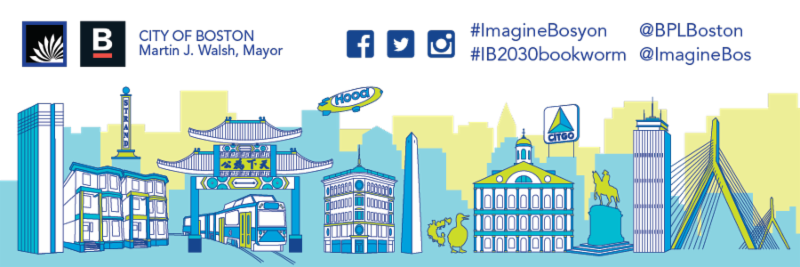Imagine Boston 2030 Announces Finallized Suggested Reading list to Engage Residents in the Conversation of Boston’s Future
|
|
|
|

BOSTON – Thursday, September 29, 2016 – As part of Imagine Boston 2030’s community engagement process, Mayor Martin J. Walsh today announced Imagine Boston 2030’s finalized suggested reading list, adding to the original list released in August. Members of the community voted on five additional books to complete both the adult and youth titles on the list. The Imagine Boston reading list offers residents the opportunity to learn more about the background on some of the history and concepts that are helping to inform conversations about the future of our city.
The texts were chosen by members of the Mayor’s team, and selected for their historical analyses and their relation to Boston. The five additional titles include: Adult Reading List
Youth (Ages 3+) Reading List
“This engagement initiative received great input from the community and has started an important conversation – one focused on how can we learn from our past to create a better Boston for the future,” said Mayor Walsh. “This finalized reading list represents a wide range of issues and stories that are relevant to all Bostonians, and together we can use these books as tools in our efforts to make Boston the best it can be in 2030.”
After the release of the initial list, Boston residents of all ages were asked to vote on the final books to complete the adult and youth selection. Members of the community responded and voted on a finalized list that includes urban histories of cities like Boston, as well as explorations of concepts and theories that shape modern cities. The goal of this initiative is to utilize this shared reading experience to develop a broader discussion with the community on the task of building a more equitable and inclusive Boston by 2030. The final Imagine Boston 2030 Reading List is below, with the new additions in bold: Adult Reading List
Youth(Ages 3+) Reading List
Imagine Boston 2030 has also asked community leaders to participate in this initiative, and many of them have been encouraged to submit blog entries discussing the readings. Each blog entry will highlight one book’s relation to Boston and its ability to add value to the planning process. These blog postings will be coming soon and will be posted on Imagine Boston 2030’s website.
Earlier this week, Mayor Walsh announced the launch of Imagine Boston 2030’s new engagement team, who will visit community events in Boston neighborhoods to seek feedback from residents on refined strategies for guiding equitable growth through 2030. The Mayor’s Office has partnered with the Boston Public Library to make the entire Imagine Boston reading list available to Boston residents. Residents are encouraged to stop by their nearest local branch to access these titles and pick up a bookmark. “Boston is a literary City and we hope that with this list, residents will not only read the books, but be encouraged to have conversations about the topics and ideas in the books, how they compare to Boston today, and how we, as a community can envision Boston in the future,” said Natalia Urtubey, Director of Engagement for Imagine Boston 2030. “We hope that this list will serve as a tool to guide community conversations around the future of Boston, and energize people to participate in upcoming engagement activities.” About Imagine Boston 2030 Imagine Boston seeks to knit together citywide planning efforts, public engagement and feedback, and City priorities to guide our city into 2030. A citywide plan will serve to implement the ideas set forth and to offer additional ideas for the physical and economic development of Boston. Just as importantly, Imagine Boston 2030 will help Boston’s citizens articulate a shared vision for equitable prosperity, innovation, education, health, equity and arts and culture.
|


